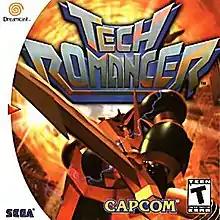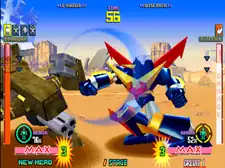| Tech Romancer | |
|---|---|
 | |
| Developer(s) | Capcom |
| Publisher(s) | Capcom Dreamcast |
| Composer(s) | Yuki Iwai |
| Platform(s) | Arcade, Dreamcast |
| Release | Arcade
|
| Genre(s) | Fighting |
| Mode(s) | Single-player, multiplayer |
| Arcade system | Sony ZN-2 |
Tech Romancer[lower-alpha 1] is a 1998 3D fighting arcade game by Capcom that draws heavily from the various subgenres of mecha anime. It was later ported to the Dreamcast console. The player controls a giant robot which is used to fight another robot in one-on-one combat. Studio Nue designed the robots in this game.
Story
The setting of Tech Romancer takes place in a far future of Earth, where advanced technology have made things calm and decent for the citizens of Japan and the rest of the world. However, the peace doesn't last long as an evil alien tyrant named Goldibus invades the planet with its loyal followers and seeks to conquer the world while enslaving the human race with an emotionless iron fist. An unlikely group of heroes band together to fight against the threat of Goldibus with their own unique mecha robots and all of them won't rest until Goldibus is defeated and the world is safe from the imminent danger.
Game modes
The game is primarily played in two modes: Story Mode, and Hero Challenge Mode. The Dreamcast version also had minigames that could be played on the VMU for points.

Story Mode
Each mecha has its own story mode, which plays out like an anime series, with each battle broken up by an episode title, eyecatch, and dialog scenes before and after each battle. Each mecha has its own story (where it is the star of its own show), and decisions made in the dialog scenes, as well as the conditions under which a battle is won, can cause some stories to branch out and have multiple paths and endings. The other mecha and characters naturally make appearances, but their role may vary from their actual origins to fit the "star" mecha's story.
Hero Challenge Mode
An "Arcade-style" mode where the player fights through each of the major mecha and bosses. Various hidden mecha and pilots found in the game can only be used in Hero Challenge Mode. In the Dreamcast version, points earned in Hero Challenge Mode and the VMU minigames could be used to purchase hidden characters including boss characters and movies.
Matching Service
In Japan, the game is re-released as "Choukou Senki Kikaioh For Matching Service" because of its online functionality.
Gameplay
Battles take place mostly on a flat 3D plane, with buildings and other terrain features scattered around. Destroying the terrain (by attacking or walking through them) releases power-ups, which include three weapons (vary between each character/mecha), armor or life powerups, and the Hero Mode powerup, which increases the power of your mecha's attacks, and may also unlock additional abilities or moves.
Rather than rounds, the matches are decided by the life meters of the fighters. Each fighter has two life meters, and is destroyed when the second one is depleted. In addition, each mecha gets an armor gauge that, when broken by consistent brute attacks, lowers the mecha's defense and makes it harder to recover from attacks received.
Each mecha has at least two super attacks, as well as a Final Attack, which is usable when the opponent is down to the last 50% of their second lifebar. This attack, when activated and successfully connected, automatically destroys the opponent, winning the battle.
Reception
| Aggregator | Score |
|---|---|
| GameRankings | 78%[2] |
| Publication | Score |
|---|---|
| AllGame | |
| CNET Gamecenter | 6/10[4] |
| Electronic Gaming Monthly | 8.17/10[5][lower-alpha 2] |
| EP Daily | 8.5/10[6] |
| Eurogamer | 7/10[7] |
| Famitsu | 29/40[8] |
| Game Informer | 8.5/10[9] |
| GameFan | (J.W.) 75%[10] (L.B.) 68%[11] |
| GameRevolution | B−[12] |
| GameSpot | 8.6/10[13] |
| GameSpy | 8/10[14] |
| IGN | 8.9/10[15][16] |
| Next Generation |
In Japan, Game Machine listed the arcade version in their November 15, 1998 issue as the fourth most-successful arcade game of the week.[18]
The Dreamcast version received favorable reviews. In Japan, Famitsu gave it a score of 29 out of 40, just one point away from Silver Awards Editors' Choice.[8] Greg Orlando of NextGen said of the game, "It's not often when we get to step into our favorite anime and beat some metal ass. Now if only the fighting were as inspired as the off-the-wall anime plot..."[17] James Mielke of GameSpot described the game as "a combination of great graphics and solid fighting fun". He noted that the game contains more replay value than JoJo's Bizarre Adventure, Street Fighter III, and Plasma Sword: Nightmare of Bilstein combined.[13] Anoop Gantayat of IGN described the game as having "the greatest single player mode ever in a fighting game" through both the game's Power Stone-style rewards system and story mode which contained branching paths and multiple endings for the playable characters.[15] BenT of PlanetDreamcast described the game as "a great surprise from Capcom" due to its Japanese anime stylings and superb character design, as well as the simple yet addictive gameplay, but criticized the overly simplistic gameplay and underwhelming graphics compare to other titles released for the Dreamcast around the same time (most notably Resident Evil – Code: Veronica which was also made by Capcom and MDK2 from Bioware).[14]
Kilo Watt of GamePro said of the game in one review, "If you're purely a fighting game fan or casual gamer, you might want to pass on Tech Romancer since it's not the pinnacle of robot fighting. For avid mech anime fans, this is one of those games you've dreamed about."[19][lower-alpha 3] In another GamePro review, however, Jake The Snake said that the game "will appeal to serious fighting game fans who like the anime-style mech basher, but casual button-mashers and mech game fans may want to pass or rent first."[20][lower-alpha 4]
Notes
- ↑ Japanese: 超鋼戦紀キカイオー, Hepburn: Chōkō Senki Kikaiō, "Chronicle of Super Steel Warrior Kikaioh"
- ↑ In Electronic Gaming Monthly's review of the Dreamcast version, two critics gave it each a score of 8/10, and the other gave it 8.5/10.
- ↑ GamePro gave the Dreamcast version two 4.5/5 scores for graphics and fun factor, 5/5 for sound, and 4/5 for control in one review.
- ↑ GamePro gave the Dreamcast version 4/5 for graphics, and three 3.5/5 scores for sound, control, and fun factor in another review.
References
- ↑ Gantayat, Anoop (June 15, 2000). "Tech Romancer Ships". IGN. Ziff Davis. Archived from the original on September 6, 2019. Retrieved October 19, 2023.
- ↑ "Tech Romancer for Dreamcast". GameRankings. CBS Interactive. Archived from the original on May 5, 2019. Retrieved May 16, 2022.
- ↑ Ottoson, Joe. "Tech Romancer (DC) - Review". AllGame. All Media Network. Archived from the original on November 16, 2014. Retrieved September 6, 2019.
- ↑ D'Aprile, Jason (June 21, 2000). "Tech Romancer". Gamecenter. CNET. Archived from the original on August 16, 2000. Retrieved May 16, 2022.
- ↑ Smith, Shawn; Sewart, Greg; Kujawa, Kraig (June 2000). "Tech Romancer (DC)" (PDF). Electronic Gaming Monthly. No. 131. Ziff Davis. p. 163. Archived (PDF) from the original on April 8, 2023. Retrieved October 19, 2023.
- ↑ Hudak, Chris (June 2, 2000). "Tech Romancer (DC)". The Electric Playground. Greedy Productions Ltd. Archived from the original on March 22, 2002. Retrieved October 19, 2023.
- ↑ Corbettis, Chris "Klamy" (August 29, 2000). "Tech Romancer (DC)". Eurogamer. Gamer Network. Archived from the original on January 7, 2001. Retrieved May 16, 2022.
- 1 2 "超鋼戦紀キカイオー [ドリームキャスト]". Famitsu (in Japanese). Enterbrain. Archived from the original on August 4, 2020. Retrieved October 19, 2023.
- ↑ "Tech Romancer". Game Informer. No. 88. FuncoLand. August 2000.
- ↑ Weitzner, Jason "Fury" (April 2000). "Tech Romancer [Import]". GameFan. Vol. 8, no. 4. Shinno Media. p. 59. Retrieved May 16, 2022.
- ↑ Buchanan, Levi (June 1, 2000). "REVIEW for Tech Romancer (DC)". GameFan. Shinno Media. Archived from the original on June 21, 2000. Retrieved September 6, 2019.
- ↑ G-Wok (May 2000). "Tech Romancer Review". GameRevolution. CraveOnline. Archived from the original on September 26, 2015. Retrieved September 6, 2019.
- 1 2 Mielke, James (January 20, 2000). "Tech Romancer Review [Import; date mislabeled as "May 5, 2000"]". GameSpot. Fandom. Archived from the original on July 26, 2016. Retrieved October 19, 2023.
- 1 2 BenT (June 20, 2000). "Tech Romancer". PlanetDreamcast. IGN Entertainment. Archived from the original on January 25, 2009. Retrieved September 6, 2019.
- 1 2 Gantayat, Anoop (January 21, 2000). "Kikaioh (Import . . . Tech Romancer)". IGN. Ziff Davis. Archived from the original on September 6, 2019. Retrieved October 19, 2023.
- ↑ Gantayat, Anoop (June 19, 2000). "Tech Romancer". IGN. Ziff Davis. Archived from the original on September 28, 2022. Retrieved October 19, 2023.
- 1 2 Orlando, Greg (June 2000). "Tech Romancer (DC)". NextGen. No. 66. Imagine Media. p. 96. Retrieved May 16, 2022.
- ↑ "Game Machine's Best Hit Games 25" (PDF). Game Machine. No. 576. Amusement Press, Inc. November 15, 1998. p. 21. Archived (PDF) from the original on March 21, 2023. Retrieved October 19, 2023.
- ↑ Kilo Watt (June 30, 2000). "Tech Romancer Review for Dreamcast on GamePro.com". GamePro. IDG. Archived from the original on December 13, 2004. Retrieved October 19, 2023.
- ↑ Jake The Snake (June 2000). "Tech Romancer" (PDF). GamePro. No. 141. IDG. p. 126. Archived (PDF) from the original on July 7, 2022. Retrieved October 19, 2023.
External links
- Tech Romancer at the Killer List of Videogames
- Tech Romancer at MobyGames
- Official Japanese Site (in Japanese)